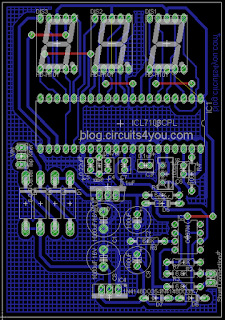Digital Ammeter using ILC7107. In this project we will learn how to make digital Ammeter using ICL7107 ? and many basic fundamentals of Ammeter design.
Designing of Digital Ammeter is basically a process of converting a voltmeter into a Ammeter.
We know that V=I x R. From this we can say that Voltage is directly proportional to the current (V = I) flowing through resistance. In ammeter this resistance is call Shunt. Shunt resistance have very small value and it will not affect the load voltage. Most commonly 75mV shunts are available in market. Or you can use low value resistance.
We are measuring voltage across the Shunt resistance that is directly proportional to the current. But practically we have to keep this voltage drop below 0.1V (100mV). So we need a amplifier to amplify this voltage. Another function of amplifier is to match the current readings with display. i.e. is called scaling.
The Intersil ICL7106 and ICL7107 are high performance, low power, 31/2 digit A/D converters. Included are seven segment decoders, display drivers, a reference, and a clock. The ICL7106 is designed to interface with a liquid crystal display (LCD) and includes a multiplexed backplane drive; the ICL7107 will directly drive an instrument size light emitting diode (LED) display. The ICL7106 and ICL7107 bring together a combination of high accuracy, versatility, and true economy. It features autozero to less than 10μV, zero drift of less than 1μV/oC, input bias current of 10pA (Max), and rollover error of less than one count. True differential inputs and reference are useful in all systems, but give the designer an uncommon advantage when measuring load cells, strain gauges and other bridge type transducers. Finally, the true economy of single power supply operation (ICL7106), enables a high performance panel meter to be built with the addition of only 10 passive components and a display.
Working:
We have designed basic Ammeter using design steps given in data sheets. It displays 3 digits i.e. 99.9 Amps maximum. Actually ICL7107 have 3 and 1/2 Display we are not using 1/2(half) display. Reference voltage of 100mV is generated using 1.2 V Zener and Variable resistor forms a voltage divider. Input is divided by 100K and 100Ohm resistor to get 200mV in-proportion.
Lets see Ammeter Desing Calculations:
Shunt Calculations:
(Note: Discription is given with referance to Simulated Circuit, Check Resistor names in Developed PCB Circuit)
1. If you are using low value resistor
Vin=RShunt x Imax
If you are using Standard Shunt that are commonly available with voltage specificaion i.e. Vin = 75mV. (Voltage Across Shunt at Max Amps)
Example : 100Amps 75mV, 50Amps 75mV
Vo is voltage given at Vin Pin(31)
Rin=R6=R7
Rf=R4=R9
1. Calculations for 100Amps Shunt
Vin=75mV
Vo=RF/Rin(Vin)
Where:
Vin = 75mV
Vo=100mV (~99.9mV)
Assume Rin=10K
Find Rin=?
Rin=R6=R7
Rf=R4=R9
2. Calculations for 50Amps 75mV Shunt
Vin=75mV
Vo=RF/Rin(Vin)
Where:
Vin = 75mV
Vo = 50mV
In this case if you calculate like this display will show 99.9 at 50Amps
for proper scaling
50Amps =>> 75mV
50mV ==>> Display Shows 50.0
So in this case Vo must be 50mV
Assume Rin=10K (You can assume Rin in the range of 10K to 50K)
Find Rin=?
Rin=R6=R7
Rf=R4=R9
How to ?
Components Value Selection:
Integrating Resistor:
Both the buffer amplifier and the integrator have a class A output stage with 100μA of quiescent current. They can supply 4μA of drive current with negligible nonlinearity. The integrating resistor should be large enough to remain in this very linear region over the input voltage range, but small enough that undue leakage requirements are not placed on the PC board. For 2V full scale, 470kΩ is near optimum and similarly a 47kΩ for a 200mV scale. Select 47KΩ (Resistor Connected at Pin 28) Vbuf
Integrating Capacitor:
The integrating capacitor should be selected to give the maximum voltage swing that ensures tolerance buildup will not saturate the integrator swing (approximately. 0.3V from either supply). In the ICL7106 or the ICL7107, when the analog COMMON is used as a reference, a nominal +2V fullscale integrator swing is fine. For the ICL7107 with +5V supplies and analog COMMON tied to supply ground, a ±3.5V to +4V swing is nominal. For three readings/second (48kHz clock) nominal values for ClNT are 0.22μF and 0.10μF, respectively. Of course, if different oscillator frequencies are used, these values should be changed in inverse proportion to maintain the same output swing. An additional requirement of the integrating capacitor is that it must have a low dielectric absorption to prevent roll-over errors. While other types of capacitors are adequate for this application, polypropylene capacitors give undetectable errors at reasonable cost. (Capacitor Connected at Pin 27 Select 0.22uF)
Auto-Zero Capacitor (Pin 29):
The size of the auto-zero capacitor has some influence on the noise of the system. For 200mV full scale where noise is very important, a 0.47μF capacitor is recommended. On the 2V scale, a 0.047μF capacitor increases the speed of recovery from overload and is adequate for noise on this
scale.
Reference Capacitor: (Pin 34, 33):
A 0.1μF capacitor gives good results in most applications. However, where a large common mode voltage exists (i.e., the REF LO pin is not at analog COMMON) and a 200mV scale is used, a larger value is required to prevent roll-over error. Generally 1μF will hold the roll-over error to 0.5 count in this instance.
Oscillator Components:
For all ranges of frequency a 100kΩ resistor is recommended and the capacitor is selected from the equation:
Reference Voltage:
The analog input required to generate full scale output (2000 counts) is: VlN = 2VREF. Thus, for the 200mV and 2V scale, VREF should equal 100mV and 1V, respectively.
Development of PCB:
Step 1: Circuit Diagram and Components required
1. 7-Segment Display Common Anode Qty. 3
2. ICL7107, and IC Base 40 Pin
3. LM7805
4. 1N4007
5. Other Capacitors and Resistors
6. OP07 Operational Amplifier
Download PDF File
Step 2: PCB Layout
Download PCB Layout pdf
Step 3: Assemble Components and Test the circuit
1. Comment if you have any questions.
2. Like, Share, Follow us on Google+










Hi,
ReplyDeleteIs there a replacement for the OP07N IC? Can't find any on the market in my region.
Please replay.
Thanks.
Nélio Abreu
You can order it from Ti.com as sample. Other OpAmp may work but don't know accuracy, this design is based on industrial Ammeters
Deleteis this circuit runs?
ReplyDeleteThis circuit is tested in simulator only.
Deleteis this circuit runs?
ReplyDeletewhat is ic4
ReplyDeletepls give the of ic4
ReplyDeleteIC4 is 7905... negative contapart of 7805... ICL7107 needs both negative and positive VC.
ReplyDelete